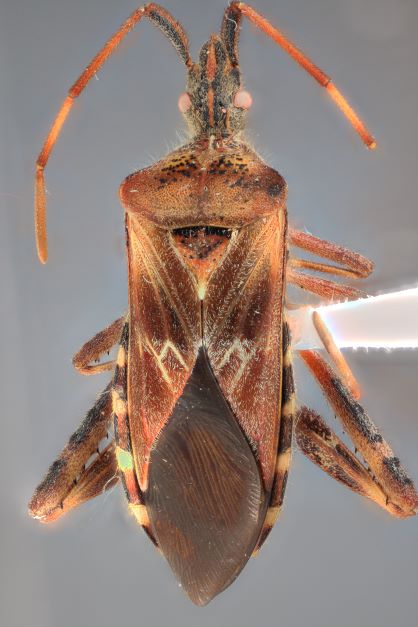Western Conifer Seed Bug (Leptoglossus occidentalis)
Western conifer seed bugs are common home invaders and often overwinter in the walls of residences and buildings.
Description/Biology:
Western conifer seed bugs are about 1/2- to ¾-inch (9-18 mm) long and feed on the seeds of pine and Douglas-fir trees. Their mouthparts are very long, formed into a stylet. The males feed on fowers and one-year old cones in the spring. Females will lay eggs in groups around needles. The adults will feed on the cones throughout the summer until they enter buildings/shelters in the winter. There is one generation per year. Most of them don’t survive the winter, but some do. You can occasionally find them around on warmer days inside the house during the winter.

Figure 1. Adult Western conifer seed bug. Photo by L.
Kerzicnik
Damage to Conifers:
They can damage some seeds but, to date, they are not known to signifcantly afect the health of pines or Douglas-fir trees.
Management:
These bugs are generally harmless to humans, pets, and structures. One rare case occurred where this insect punctured holes in cross-linked polyethyelne tubing (typically for use with plumbing). They are not currently known to reproduce indoors or to vector any diseases. They are often mistaken for the kissing bug species (assassin bugs) that can vector Chagas disease, and we currently do not have these species in the state. The number of western conifer seed bugs entering the home is variable; it depends if you have several conifers adjacent to the home. To keep the bugs from coming into your house/building, you can keep the window screens intact, caulk or foam any openings or cracks, and do the same for door areas. You can also vacuum up any bugs seen.
To learn more about the topics discussed on this page, contact the Schutter Diagnostic Lab. If you suspect an infestation on your property, contact your local extension agent, the Schutter Diagnostic Lab at Montana State University, or the Montana Department of Agriculture.
This November 2022 fact sheet is also available as a Printable PDF (416KB).
Disclaimer: These recommendations are provided only as a guide. It is always the pesticide applicator’s responsibility, by law, to read and follow all current label directions for the specific pesticide being used. The authors and Montana State University assume no liability resulting from the use of these recommendations. The Montana State University Extension Service is an ADA/EO/AA/Veteran’s Preference Employer and Provider of Educational Outreach.
